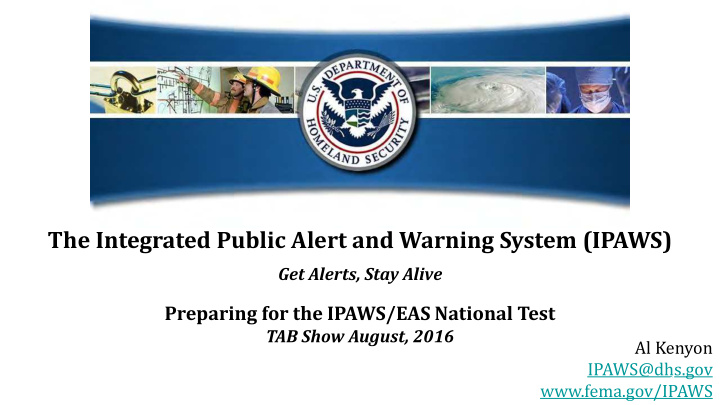



The Integrated Public Alert and Warning System (IPAWS) Get Alerts, Stay Alive Preparing for the IPAWS/EAS National Test TAB Show August, 2016 Al Kenyon IPAWS@dhs.gov 1 www.fema.gov/IPAWS
The First National EAS Test • November 9, 2011- the first ever nationwide test of the National EAS • Activation and message distribution via Primary Entry Point (PEP) system • Used actual Presidential activation Emergency Action Notification (EAN) code • EAS devices indicated that it was an actual alert driven by EAS header data. An intense public outreach campaign was mounted to avoid undue public concern.
Findings From the First National EAS Test • We need additional PEP sources • Some EAS devices handled the test message differently than others • Video message displays varied in legibility and effectiveness • There were audio quality issues • EAS Participants cited problems with the available reporting mechanism 3
FEMA added 34 new PEP stations plus an additional network partner In Texas, that’s: KROD, El Paso KLBJ, Austin plus service from KWKH, Shreveport. Premiere Networks has a standby uplink in San Antonio. 4
Adding IPAWS to the mix 5
Next Steps • Phase I – Controlled testing at the IPAWS Lab All photos FEMA photographer Manny Centeno 6
Next Steps • Phase II – Live State/Regional tests using the National Periodic Test (NPT) code 7
Next Steps • Phase III – The Live Nationwide Test “PEP” Originator Code • • “NPT” Event Code “000000” All -US Location Code • Delivery via IPAWS EAS Atom Feed • PEP stations will use their studio EAS equipment • • Test message will contain both English and Spanish spoken word and text 8
Test Message XML Full Message Text MP3 Audio – (Replaced by URI for hosted file) Signature Certificate 9
10
Message Reception Time • Typical log report: “Received CAP decoded from IPAWS at 2:20:45; received LP1 at 2:21:50.” • IPAWS message reception time is a product of the EAS Device polling interval. Alert Station A Receives Alert OTA Posted Station A Polling Interval Station B Polling Interval B Sends Alert 11
EAS Watch Screen @ 14:31:35 RX at 14:30:31 IHeartMedia Emergency Operations Center Photo by FEMA photographer Al Kenyon 12
Contacts U.S. Department of Homeland Security Antwane Johnson 500 C Street SW Division Director Washington, DC 20472 IPAWS Program Office: National Continuity Programs, 202.646.4383 Office Prevention & National Antwane.Johnson@fema.dhs.gov IPAWS@dhs.gov Preparedness IPAWS@dhs.gov U.S. Department of Homeland Security Al Kenyon 500 C Street SW Technical Lead Washington, DC 20472 IPAWS National Test Visit: 202.212.3308 Office IPAWS Division Alfred.Kenyon@fema.dhs.gov National Continuity Programs IPAWS@dhs.gov http://www.fema.gov/ipaws/ Prevention & National Preparedness 14
For more information EMI Independent Study Courses: – IS-247a: IPAWS Introduction https://training.fema.gov/EMIWeb/IS/is247a.asp – IS-248: IPAWS for the American Public http://training.fema.gov/EMIWeb/IS/courseOverview.aspx?code=IS-248 – IS-251: IPAWS for Alerting Authorities http://training.fema.gov/EMIWeb/IS/courseOverview.aspx?code=IS-251 IPAWS Stakeholder Information and Webinar Mailing Lists: http://www.fema.gov/integrated-public-alert-and-warning-system-working-groups 15
FEMA Primary Entry Point (PEP) Stations • To satisfy requirement for a nationwide alert capability for warnings about a national catastrophic event, FEMA maintains relationships and equipment at a number of private sector radio stations across the US. • FEMA PEP stations include: – extended backup power generation system – special communications connections – back up transmitter and EMP protection Photos FEMA photographer Al Kenyon 16
Recommend
More recommend